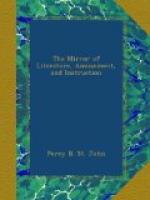The fifth piece likewise upon 4 iron supporters, was a globe of about 12 inches diameter, cut into 14 planes, viz. 8 triangles, equal and equilateral; and the other 6 were equal squares. The dials on these planes showed the usual hour by the shade of a fleur-de-lis fastened to the top or bottom of each plane.
The last, or top piece of the pyramid, was a glass bowl of 7 inches diameter, upon a foot of iron. The north side of this piece was thinly painted over white, that the shade of a little golden ball, placed in the middle of the bowl, might be seen to pass over the hour-lines which were drawn upon the white colour, and noted the hour. The bowl was included between two circles of iron gilt, with a cross on the top.
Such is a general description of the parts or divisions of this very curious Dial. To which may be added that the first four pieces had all their sides covered with little plates of black glass, first cemented to the said pieces, except those places whereon the dials were drawn; which being also covered with plates of polished glass, nearly the whole of the outside of the dial appeared to be glass; the angles or corners being elegantly gilt, as were in part the iron work of the pyramid, supporters, branches, styles, &c.
We have abridged and in part rewritten this explanation from upwards of six closely-printed 4to. pages. After the general description, in the original tract, the different sections or parts of the dial, 73 in number, are still further explained, and illustrated by 17 plates, besides a vertical section, of which last our Cut is a copy. Perhaps these details would tire the general reader, and on that account we do not press them: a few of them, however, may be noticed still further.
Of these, the Bowls appear to be the most attractive. One on the first piece, by fire was a little glass bowl filled with clear water. This bowl was about three inches diameter, placed in the middle of another sphere, about six inches diameter, consisting of several iron rings or circles, representing the hour circles in the heavens. The hour was known by applying the hand to these circles when the sun shone, when that circle where you felt the hand burnt by the sunbeams passing through the bowl filled with water, showed the true hour, according to the verse beneath it:
Cratem tange, manusq horam tibi reddet adusta.
The phenomenon is thus explained by the Professor: “the parallel rays of the sun passing through the little bowl, are bent by the density of the water, into a cone or pyramid, whose vertex reaches a little beyond those hour circles, and there burns the hand applied; for so many rays being all united into a point, must needs make an intense heat, which heat is so powerful in the summer-time, that it will fire a piece of wood applied to it.”




